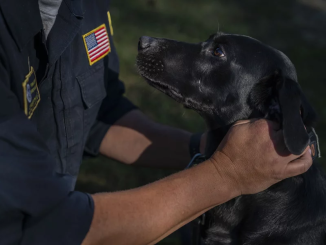Amaryllises are popular flowers for the holidays. They start appearing on store shelves in gift and growing kits in the fall when the holiday displays go up. They make great gifts for houseplant and gardening enthusiasts, but they are also popular as alternative (or complementary) Christmas and New Year’s decorations.

If decorations and displays are what you’re after, and you want to have your amaryllis blooming for holiday decorating, you’ll need to plan ahead and plant ahead.
When Do You Plant Amaryllis for Christmas Blossoms?

Amaryllis grow quickly and can flower anywhere between four to eight weeks after they are planted. The average is around six weeks. It’s wise to start planting in early to mid-November if you want the plant to be flowering for Christmas.
Here are some tips for a successful blooming planting:
- Amaryllises need to feel a root or pot bound to the flower. Plant your bulb(s) in a pot no bigger than one inch larger than the bulb (measured at the widest point of the bulb)
- The pot should be twice as tall as the bulb so the roots have enough room to grow
- It’s important that the pot has drainage holes
- Plant in a good quality potting mix
- An amaryllis planting kit should have all you need to start the bulb and the pot will be the right size
- The bulbs should not be completely covered—about one-third of the bulb’s top should be sitting above the soil
- When you first plant your bulb, take it to the sink and thoroughly water the plant until the soil is wetted all the way through
- Leave the pot in the sink for an hour or so to allow all excess water to drain, then put the pot on a saucer and move it to a place with bright, indirect light
- Do not overwater amaryllis bulbs
- Let the top of the soil dry out between waterings.
- Amaryllis prefers a cooler room over a warmer room (around 65 F or 18 C)
Plant More than One Bulb for More Reliable Blooms

Each amaryllis blossom will last for about two to three weeks. And of course, we can plan the best we can, but everyone’s growing conditions are a little different in their home, and plants will do what each individual plant naturally does.
Doing what comes naturally, of course, means the bulbs can have a little bit of a mind of their own. If you really want to hedge your bets for blossoms for Christmas (and potentially through New Year’s), plant more than one bulb.
- The number of flowers that one bulb grows is related to the bulb size
- Choose larger bulbs for more flowers
- Flower stalks may also grow and bloom successively, so large bulbs with more flower stalks also increase the chances of having flowers for the holidays
Plant in Succession to Hedge Bets for the Right Bloom Time

Another way to increase the likelihood of having your amaryllis bulb blossom when you want it to is to plant a few bulbs in succession.
Plant one or more bulbs every week or every two weeks. If you choose to do this, start earlier than November—mid to late October—and plant weekly or biweekly through the month of November.
At the very least, you’ll have a long succession of blooms to enjoy over many weeks. If you plant every week, you have the best chance of hitting the holidays just right.
If you plant every two weeks, you should have at least one flower in bloom consistently for as many bulbs as you started. That could mean well over a month of beautiful blooms!
- Amaryllis bulbs can be on the more expensive side, but with good aftercare, your bulb can bloom again
- Kits make planting easy, but you often can’t inspect the bulb in kits
- Bare amaryllis bulbs are cheaper, and you may be able to pick through to find the best (if you’re buying in person at a garden center or store)
- You can usually get two blooms per year; then the plant needs to die back from its foliage to store energy to grow again
- You can just be done with the plant after the first bloom and let it go dormant if you don’t care to manage it that much
Plant Different Varieties to Increase the Odds

Different varieties of amaryllises have different growing and bloom times, so you can increase your chances of having blossoms on Christmas Day (or New Year’s Day, or both) by planting more than one variety.
Pick out a few that strike your fancy.
- Amaryllis bulbs can be put into dormancy after they die back
- You can save them and regrow them for many years
- You will have the widest variety of flowers by shopping for single bulbs and not kits
Fertilize Regularly to Boost Blooms

To speed up blossoming and give the plant what it needs to support those large flowers, fertilize your amaryllis every time you water it.
Start giving the bulb fertilizer in its water when you see new green growth poking out of the bulb (some bulbs come already sprouting, so fertilize those when you pot them—flowering takes a lot of energy out of a plant).
Even newly purchased amaryllis bulbs should be fertilized.
- Use a water-soluble fertilizer
- Phosphorous is what promotes blossoming in amaryllis, so choose a fertilizer with a high phosphorous content
- On the fertilizer label, phosphorous (abbreviated as “P”) will be the middle number
- For example, if the label has three numbers like 15-30-15, the middle number is the phosphorous content—the 30
- Phosphorous content should be at least as high as the other two, preferably higher
- Mix the fertilizer at half the strength recommended on the label and feed it every time you water once the plant starts growing
- Do not overwater amaryllis, or the bulb will rot
- Only water when the top inch of soil is dry
- Avoid pouring water on the neck of the bulb (the exposed part above the soil)
A Few Final Tips to Keep Amaryllis Looking Lovely

- Amaryllis grow quickly and bend toward the light, so turn the bulb every day or two, so it grows evenly and straight up
- Stalks are tall, and flowers are heavy—they can be anywhere from four to ten inches in diameter
- You may need to stake the flower stalk to keep it from bending
- Give your amaryllis a pretty topiary look by gently tying or wiring the flower stalks together at the top
- Tying also helps the stalks support each other
- You can tie flower stalks together on the stake, too, which hides the stake and lends support
- Sellers are now offering unique waxed amaryllis bulbs that are ready to grow and require no watering–an interesting option!
- Amaryllises make great gifts—give kits or start some ahead to give as grown and flowering plants
- A beautiful, blooming amaryllis is the perfect holiday hostess gift

- Paperwhites are smaller but much-loved Christmas flowering bulbs, too
- Paperwhites grow similarly and in about the same bloom time as amaryllis (a little quicker)
- They complement amaryllis nicely, either together in one pot as a holiday bulb garden or set together in separate pots
- If you’re not sure if you have time to get your amaryllis to bloom exactly when you want it to, or if your started bulbs are taking longer to bloom than expected, buy a fully grown plant that is in flower at the time you want it
- You can still save the bulb from flowering full plants after it’s done to regrow for reblooming or to save for next year
“Inspirational Video: Visually Impaired Dog Shines Playing the Piano and Harmonizing with Sibling, Captivating Online Audiences and Becoming a Social Media Sensation”

A visually impaired beagle named Buddy Mercury has gained international acclaim on social media for forming an incredibly charming musical duo with his human sister. Despite his blindness, this music-loving canine exhibits remarkable piano-playing skills and harmonizes delightfully with his partner, showcasing a joyful spirit that remains undiminished.

Buddy Mercury, an eight-year-old beagle mix who was rescued, resides in Long Island, New York, with his human parents, Laurie and Glen Wolfe, and their 5-year-old daughter, affectionately referred to as Buddy’s “Lil Sis.” The couple adopted Buddy from a North Carolina animal shelter in April 2016 after he was discovered as a stray. They welcomed their daughter into the family the following year.

Laurie, 41, and Glen, 42, shared that Buddy has always been an integral part of their daughter’s life, fostering a heartwarming and endearing bond between the two. “It’s been a really sweet relationship to watch,” Laurie mentioned to The Epoch Times.
Buddy Mercury’s remarkable musical journey began just three months after his adoption, when Glen was taken aback while watching television. The piano unexpectedly started playing on its own, leaving Glen astonished. Quickly recording the enchanting moment on his phone, Glen captured Buddy playing the piano.

Initially, Buddy started “singing” in response to sirens from a nearby fire station. Soon, this became a routine, and Buddy began making musical melodies multiple times a day. Laurie shared, “It became part of his routine, and he’s really very happy when he plays because his tail is always wagging when he’s at the keys.”
Glen, a professional drummer, vividly remembers one of their earliest viral videos, in which their daughter entered the room with a guitar. The sequence of events that followed was nothing short of magical, as Buddy, looking out the window, joined in with his musical talents. “It was a magical moment, just unforgettable,” Glen fondly recalled.

In the summer of 2021, Laurie and Glen noticed a change in Buddy’s eyes. Upon seeking veterinary care, they were informed that Buddy had progressive retinal atrophy, a hereditary condition leading to complete blindness. Despite the heartbreak, the vet emphasized the importance of maintaining Buddy’s routines, including his piano-playing. “Through our tears we were smiling,” Laurie shared.
Although Buddy now faces challenges due to his blindness, Laurie and Glen administer eye drops to ensure his comfort. Despite occasional bumps into objects, Buddy’s independence remains strong. In solidarity with Buddy’s adjustment to life without sight, the couple has chosen not to adopt more animals.
Their heartwarming family band, featuring their daughter’s singing and Buddy’s piano-playing, serves as a compelling message advocating for animal adoption. Buddy frequently participates in community events, fundraisers, and interviews, where he enthusiastically performs in exchange for treats.

While Laurie and Glen maintain their day jobs, they hold onto the possibility that their unique musical collaboration could eventually lead to new opportunities. Laurie expressed, “There’s a lot going on in the world, but I think that there’s no better cure for whatever is hurting someone [than] choosing to rescue an animal.”



Leave a Reply